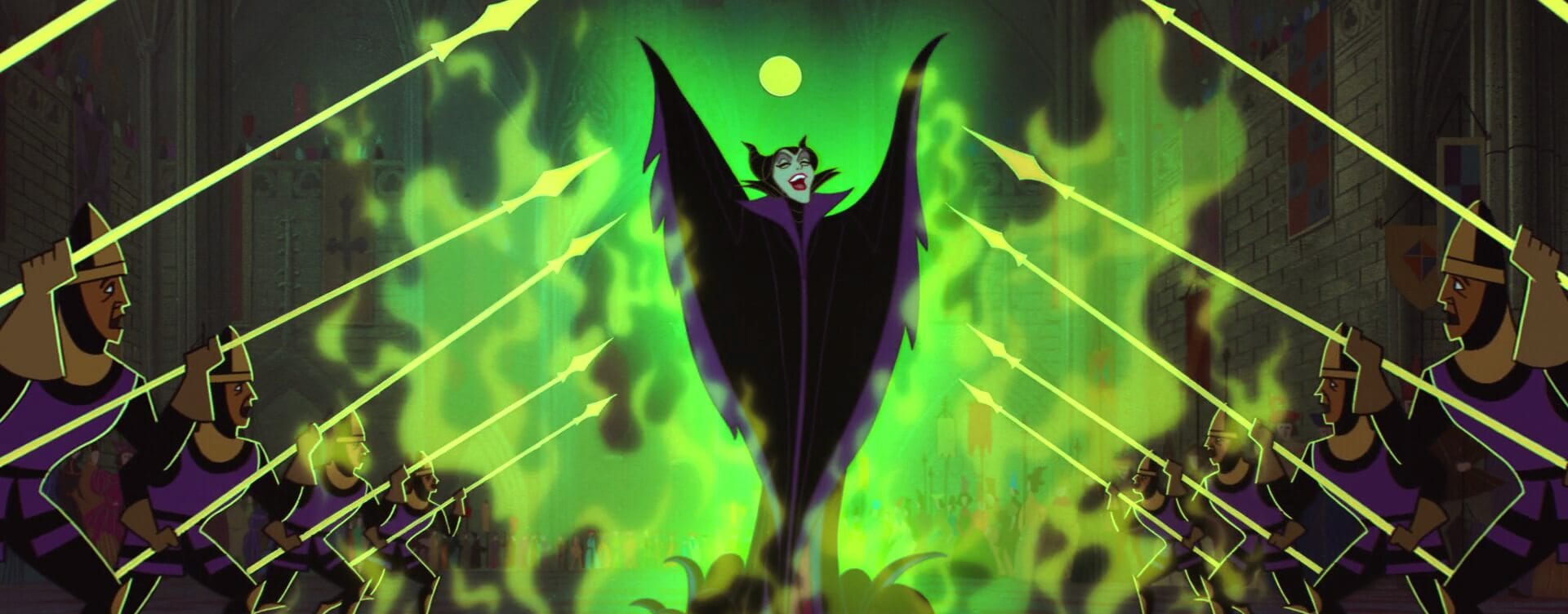Top 5 Disney Villains
“Now, shall you deal with ME, O Prince – and all the powers of HELL!”
Throughout Disney animation’s long history, their villains have become just as iconic as their heroes. Some even prefer the villains and consider them more relatable and nuanced. Personally, I don’t feel that way, but I do think a movie should have a villain just as compelling as its hero. In the spirit of Halloween, I’ll be talking about some of my favorite Disney villains and what makes them stand out among such a long legacy of dastardly devils. I’ll only be ranking animated villains today, so for baddies like Maleficent who have been remade in live-action, only the original animated version will be considered. I’ll also only be ranking the main antagonists, so sidekicks like Le Fou and Flotsam and Jetsam aren’t included.
*Spoilers*
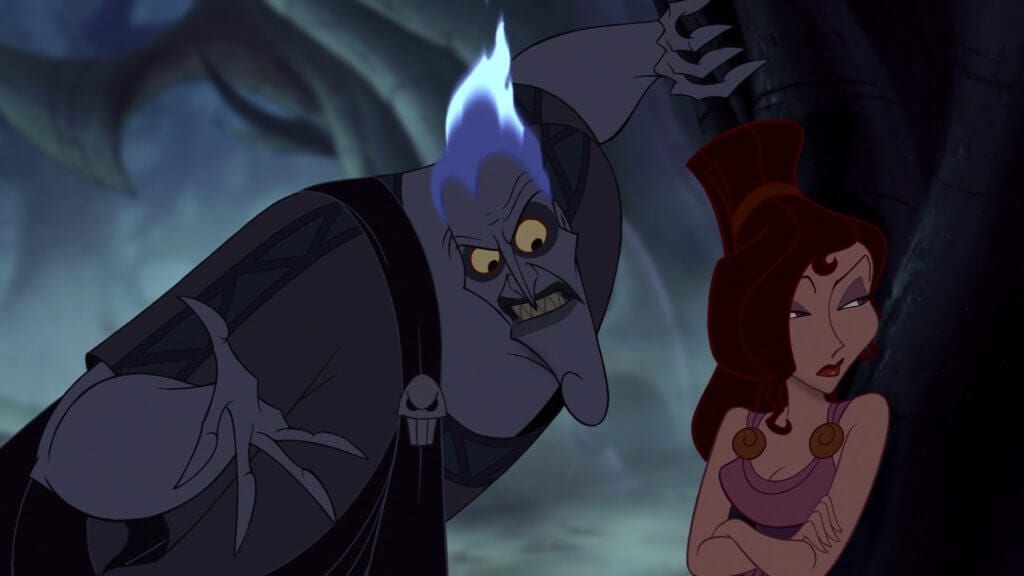
5) Hades, Hercules, 1997
James Woods’ take on Hades is very different from anything that had come before. He wanted his version of the God of the Underworld to seem less like a serious, grim brooder and more like a lawyer or a car salesman. This works to tremendous effect; Hades is far and away one of the funniest Disney characters, and he’s the second best character in this movie. He’s not a particularly interesting one, as his motivation and plan are pretty straightforward, but Woods’ delivery hits the nail on the head every time. He also ad-libbed a lot of his lines, much like Robin Williams’ celebrated turn as Aladdin’s Genie. Hades doesn’t get his own song in the film, but I’d be curious to see/hear what he would have sung about. His relationship with Megara is also interesting, and they share some of the film’s best scenes. The Lord of the Dead himself has arrived at spot number five on my favorite Disney villains.

4) Gaston, Beauty and the Beast, 1991
When Gaston enters the story in Beauty and the Beast, he seems like a mild nuisance, and as directors Kirk Wise and Gary Trousdale observe in the film’s audio commentary, in any other Disney film he would be Belle’s love interest. Likewise, the Beast is at first an antagonist to Belle, making her choose between her own freedom and that of her elderly father. “Gaston” serves as a great villain song because it’s so upbeat and happy and fun that you almost forget what a douche the guy is. Of course, it also displays that pretty much everybody in the village – except for Belle – worships Gaston. They all think he’s a stand-up guy and that Belle and Maurice are weirdos, so of course it’s easy for him to turn the villagers against them in the climax. He also disappears for significant chunks of the film’s runtime, making it easy to forget he’s even there, let alone the fact that he poses a significant threat to the heroes. They really botched Gaston in the 2017 remake, as much as I enjoyed Luke Evans’ performance. They gave him strange character moments, like when he mentions fighting in the wars and when he tries to help Maurice find Belle. It’s like they tried to make him more sympathetic, but what you get is an uneven character with no distinct motivation or arc. This just can’t match Richard White’s performance and the animation by now Disney legend Andreas Deja. Gaston was Deja’s first villain. In the original animated film, there’s no man in town as admired as Gaston, and his two-faced nature makes him my fourth favorite Disney villain.
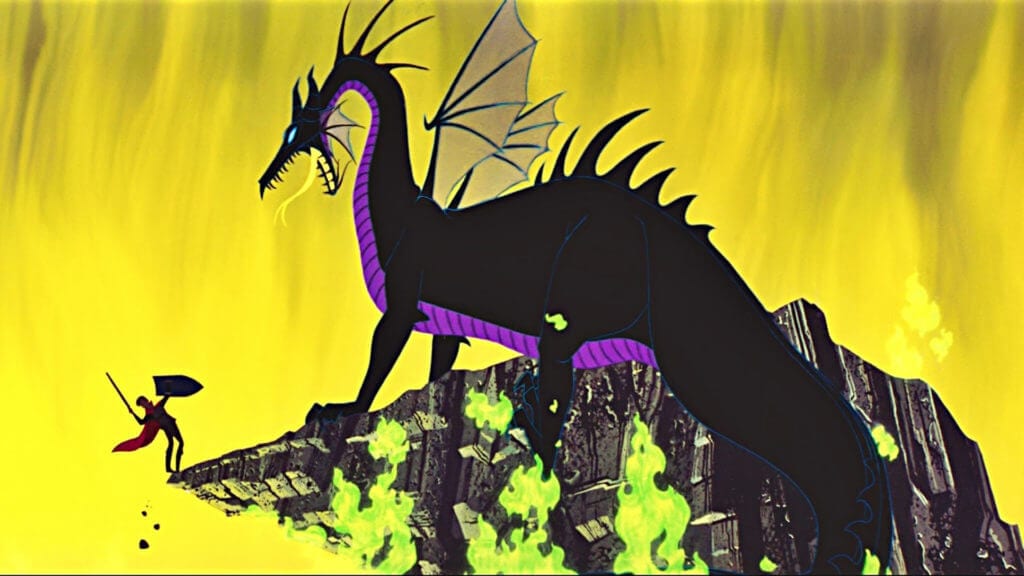
3) Maleficent, Sleeping Beauty, 1959
This character was bound to be on the list somewhere; it was only a matter of which spot. Contrary to the 2014 remake/retelling Maleficent, this is one character who has no redeeming qualities whatsoever. However, the way it’s executed is absolutely delicious. The great Eleanor Audley provides the voice of the wicked fairy, having earlier voiced Lady Tremaine, Cinderella’s stepmother. You can feel how much fun she must have been having with her line delivery. It’s hard to even picture the actress doing the work because the voice and the design are so iconic that Maleficent feels like an entity in and of herself. She’s a grand, dramatic character, and compliments the film’s tone so well. The speech she delivers to Prince Philip is one of the best moments in the movie, and it’s topped by her iconic death scene, in which she famously turns into a dragon and battles the sword-and-shield-wielding prince. Everything from Maleficent’s design to her voice to her dialogue is pure magic, and it takes a lot to make a character with no real motivation and no redeeming traits this much fun to watch. Characteristic of the time, there is a lot of Christian imagery invoked in the ultimate battle between Maleficent and Philip; she looks devilish and unholy, and literally refers to the powers of Hell when she transforms, while Philip carries a shield with a cross on it. This could just be the artists trying to keep the setting and time period in mind, but in context, it seems like Philip has a higher power on his side, as well as the three good fairies. Much like with Gaston, I have mixed feelings about Maleficent’s live-action incarnation. Angelina Jolie kills it in the role and seems to be carrying the rest of the film on her back, but if they wanted to take a villain and make them into a tragic hero, this wasn’t the one. They also turn king Stephen and the good fairies into bumbling idiots so that Maleficent can save the day. The animated Maleficent shapeshifts, curses her enemies, and summons the very powers of Hell, and that makes her my third favorite Disney villain.
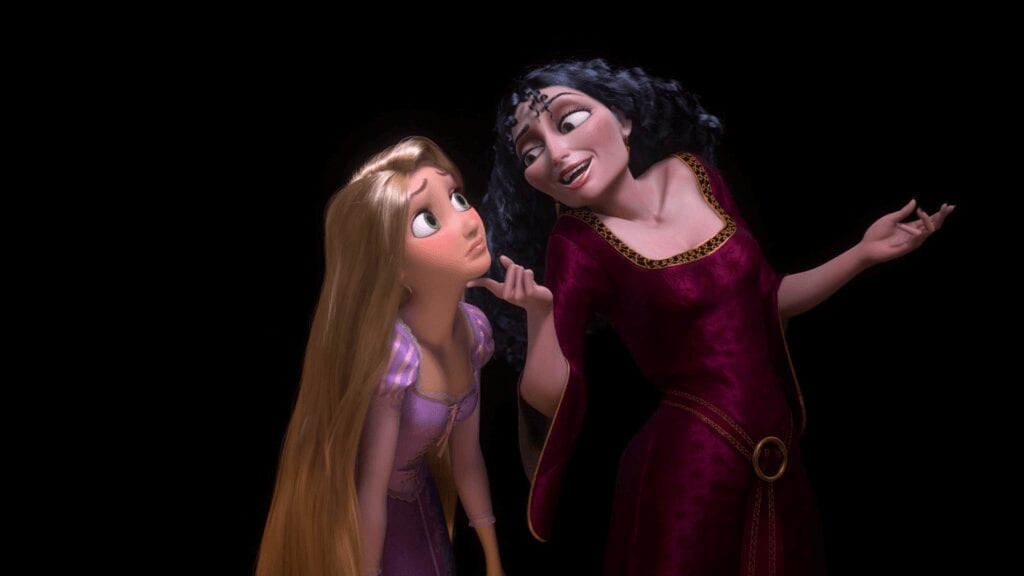
2) Mother Gothel, Tangled, 2010
Mother Gothel is an interesting character because of her duplicitous nature. She does bad things out of self-interest and preservation, such as trying to take some of Rapunzel’s hair and ultimately kidnapping her. Once she has the girl in her keeping, she’s also manipulative, deceitful, and something of a bully. However, It seems to me that Gothel does love Rapunzel in some way, maybe in the only way someone so self-absorbed can. She especially seems loving and attentive towards Rapunzel in the prologue when she’s a little girl. In the main story in the present, it becomes increasingly clear that Gothel serves as a repressive force in Rapunzel’s life, holding her back from seeing the world and meeting new people. Gothel seems less like someone who doesn’t feel love at all and more like an abusive parent who just values her own feelings and needs over those of others, including Rapunzel. This is a surprisingly complicated relationship, and I’m shocked it isn’t talked about more often. Gothel does things for Rapunzel that don’t benefit herself at all, like celebrating her birthday with her favorite soup and agreeing to travel and get her rare paint for her murals. However, in the end, she finally establishes once and for all that she doesn’t care about Rapunzel’s happiness if it conflicts with her own; rather than allowing Rapunzel and Eugene to leave, she takes Eugene out of the equation to keep Rapunzel with her. Gothel is a terrible person, but it’s her relationship with Rapunzel that makes her death bittersweet. Even Rapunzel herself reaches out to try and stop her from falling. I do find it interesting that, while Gothel falls from the tower and it’s her own fault for not being careful, this is one rare case with Disney where one of the heroes arguably kills her; even though she was tumbling near the window through her own carelessness and grief, Pascal ultimately trips her. However, Gothel is also dramatic, and very funny at times. This was likely the hardest part to play in this film, and Donna Murphy absolutely nails it. The reprise of “Mother Knows Best” is one of the most chilling moments in any Disney movie, and when she sings “Don’t come crying” I get goosebumps every time. In most variations of the Rapunzel story, Gothel is a witch, so I was surprised that Disney elected to make her a normal human, although she does arguably use magic when she sings the incantation to activate the flower’s healing properties. I think taking away any supernatural aura she may have had works really well, though, because the scariest villains are sometimes regular humans who do unforgivable things. Mother knows best, at least enough so to be my second favorite Disney villain.
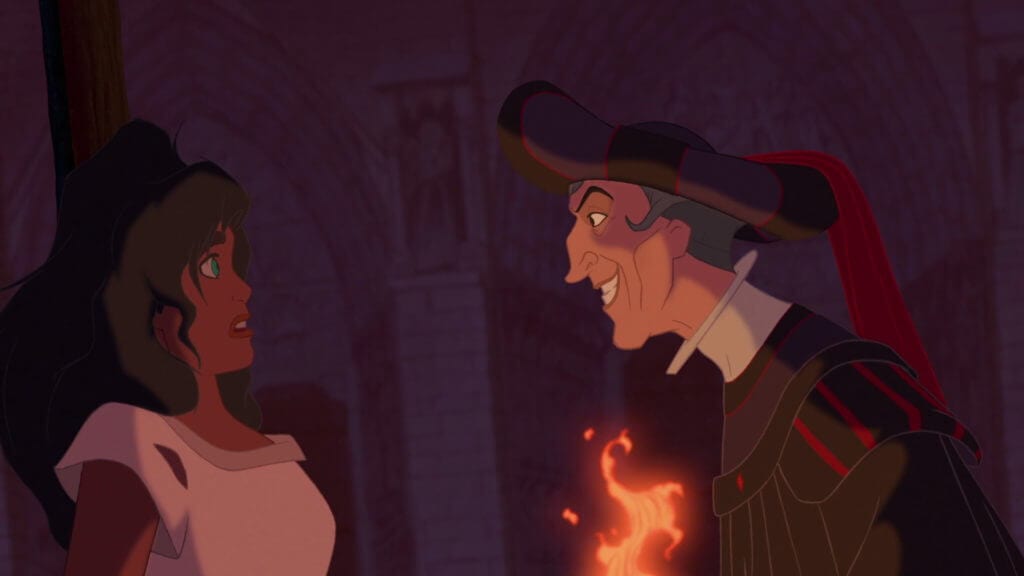
1) Judge Claude Frollo, The Hunchback of Notre Dame, 1996
Frollo doesn’t possess any supernatural abilities, and it would be difficult to argue that he’s charismatic, but he’s the scariest Disney villain because he could very easily be real. We all probably know people who would behave like this if they had any real clout. Frollo is racist, sees women as objects, and his adopted son as merely a tool to meet his goals. Any one of these things would be enough to create a despicable foe, but what really makes him an interesting character is his religious faith. Frollo not only believes he’s right; he thinks he’s the vessel to bring about God’s will by weeding out the sinful and the unworthy. Like Gothel, Frollo has a very complicated relationship with his adopted son, although it would be hard to argue that he loves Quasi in any way. He also has “Hellfire,” which is not only the best Disney villain song, but one of the best Disney songs ever. Tony Jay expertly provided the voice of Frollo, allowing him just enough humanity to make his horrendous actions believable. Sometimes I’m taken aback by the fact that a character like this even made it into a Disney film. In the “Hellfire” sequence, he says in no uncertain terms what the audience has already suspected – that he would like to force himself upon the gypsy girl Esmeralda, and that if she won’t give him what he wants, he’ll see her burn. While most Disney villains have fallen to their deaths in one form or another, it’s interesting to me that Frollo’s death scene is the only sign of anything supernatural in the film: as he’s falling he grabs onto a gargoyle, and it comes to life and sends him plunging to his doom. While people have argued that the talking gargoyles are a figment of Quasimodo’s imagination, that would serve a narrative purpose: to show his deteriorating mental state and provide comic relief. Why show Notre Dame literally passing judgment on and killing Frollo if it’s not really happening? Unlike the benevolent Archdeacon, Frollo twists up the teachings of his religion and uses it to justify his sick morality and behavior, and ultimately, divine intervention leads to his damnation. He truly believes that what he’s doing is for the greater good and the glory of God, and that makes Frollo the most interesting and disturbing Disney villain. Stripped of any superpowers or magic, Frollo is just a regular human with flaws and a moral code, and that makes him the scariest villain of all. Frollo may be proud of his virtue, but he’s also a monster, and it’s this dichotomous nature that makes him the best Disney villain.
Honorable Mentions:
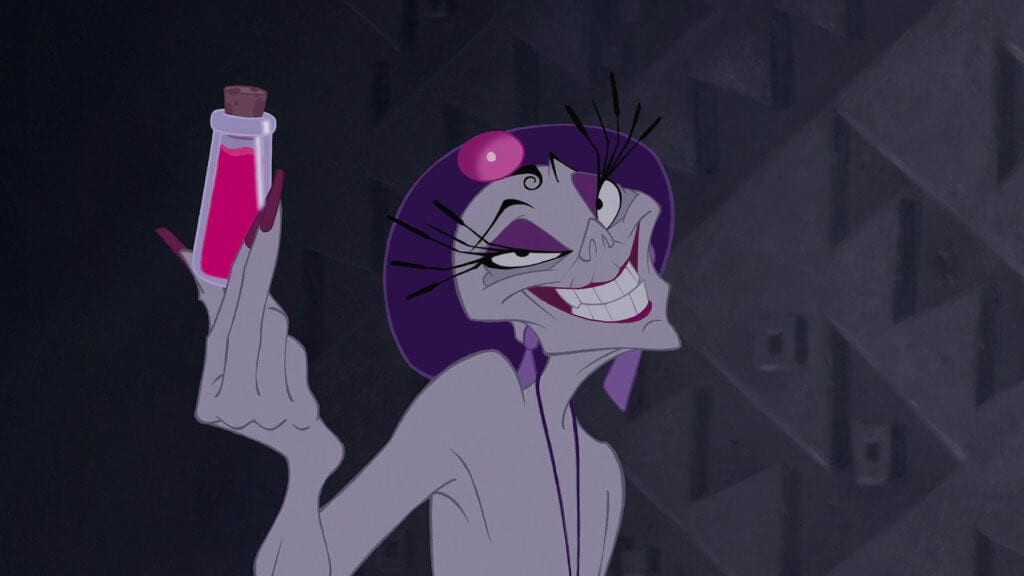
Yzma, The Emperor’s Groove, 2000
Yzma is voiced by Eartha Kitt, and in a movie that’s already laugh-out-loud funny, she delivers a few zingers for sure. Some of the film’s best jokes are actually at her expense. The character’s design is so outlandish, and Kitt’s voice work fits perfectly with it. Yzma didn’t make it to the top five Disney villains, but she deserves some credit for being hilarious and deliciously evil. Her fate is equally hysterical, and I won’t spoil it here.
Lady Tremaine, Cinderella, 1950
While Lady Tremaine is no Maleficent, Eleanor Audley plays the wicked stepmother with such delight that you just have to love to hate her. The character’s design is also gorgeous and refined, and she is very intimidating throughout the film.
Dr. Facilier, The Princess and the Frog, 2009
Keith David is a phenomenal voice actor, and this spooky voodoo practitioner also gets big points for being the best villain put out by the Mouse House in a decade.
Ratigan, The Great Mouse Detective, 1986
Ratigan is extremely entertaining. Vincent Price portrays an evil rat who just likes to be bad and has no qualms about it. “Goodbye So Soon” is a catchy song, and Ratigan is hilarious and wonderfully malicious throughout the film.
The Evil Queen, Snow White and the Seven Dwarfs, 1937
Much like with Maleficent, no list of Disney villains would be complete without the Queen herself. The Queen’s design is stark and dramatic, and her old hag disguise is equally iconic. Lucille La Verne created the standard by which all future Disney villains would be judged, and she set the bar high.

